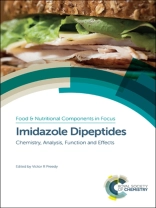Carnosine and anserine are two common histidine-derived dipeptides, also known as imidazole dipeptides, found in muscle and brain tissues of animals. Their dietary and nutritional significance lies in their antioxidant properties and a number of investigators are looking at other health benefits of the compounds.
This volume surveys the current state of play in these and other areas of interest, including chemistry and biochemistry, immunology and cellular homeostasis. Chapters look in depth at some of the functions and effects in the body particularly with regard to exercise and fatigue, wound healing, cancer treatment and age-related diseases. Providing an up to date, interdisciplinary approach, this book is of great interest to researchers and professionals in chemistry, food science, nutrition, biochemistry, health sciences and sports sciences.
Innehållsförteckning
Carnosine in the Context of Histidine Containing Dipeptides; Carnosine and its Homologues in Foods; The Chemistry of Imidazole Dipeptides; The Chemistry of Carnosine Derivatives; Chiral Carnosine; The Biochemistry of Enzymes Producing Carnosine and Anserine; The Biochemistry of Anserine and Carnosine Degrading Enzymes; Carnosine and Derivatives as Inhibitors of Protein Covalent Modifications Induced by Reactive Carbonyl Species; Antioxidant Activity of Imidazole Dipeptides – Prevention of DNA and Protein Degradation; Liquid Chromatography Coupled to Tandem Mass Spectrometry to Analyse Imidazole Dipeptides; Antioxidant Activity of Imidazole Dipeptides; Inflammaging, Oxidative Stress and Carnosine: Role of Hormetic Vitagenes; Carnosine and the Control of Blood Glucose; Carnosine and the Control of Blood Glucose; Beta-Alanine, Muscle Carnosine and Exercise; Human Skeletal Muscle Carnosine and its Function: A Focus on Homeostasis, Muscle Contractility and p H; Anserine as a Suppressor of Fatigue; Carnosine Promotion of Wound Healing; Carnosıne and Ischemıa/Reperfusion Injury; Anti-Genotoxic Effects of Carnosine; Carnosine and Cancer; L-Carnosine and Human Colon Cancer; Carnosine-induced Neuroprotection; Carnosine and Vascular Dementia; Carnosine and Alzheimer’s Disease-related Fibril Formation; The Function of Carnosine and its Homologues on Behaviour; Carnosine and Kidney Diseases; Carnosine Protection Against Liver Injury; The Blood-Retinal Barrier and Carnosine; L-Carnosine and Zinc in Gastric Protection
Om författaren
Victor R. Preedy is a senior member of King’s College London (Professor of Nutritional Biochemistry) and King’s College Hospital (Professor of Clinical Biochemistry; Hon). He is attached to both the Diabetes and Nutritional Sciences Division and the Department of Nutrition and Dietetics. He is also Director of the Genomics Centre and a member of the School of Medicine. Professor Preedy graduated in 1974 with an Honours Degree in Biology and Physiology with Pharmacology. He gained his University of London Ph D in 1981 and in 1992, he received his Membership of the Royal College of Pathologists. Professor Preedy was elected as a Fellow of the Institute of Biology in 1995 and to the Royal College of Pathologists in 2000. Since then he has been elected as a Fellow to the Royal Society for the Promotion of Health (2004) and The Royal Institute of Public Health and Hygiene (2004). In 2009, Professor Preedy became a Fellow of the Royal Society for Public Health and in 2012 a Fellow of the Royal Society of Chemistry. During his career, Professor Preedy has worked at the National Heart Hospital (part of Imperial College London) and the MRC Centre at Northwick Park Hospital. He has collaborated with research groups in Finland, Japan, Australia, USA and Germany. He is a leading expert on nutritional and food sciences and has a long standing interest in how food, food quality, nutrition and diet affect wellbeing and health. He has lectured nationally and internationally. To his credit, Professor Preedy has over 600 publications, which includes peer-reviewed manuscripts based on original research, abstracts and symposium presentations, reviews, books and volumes.












